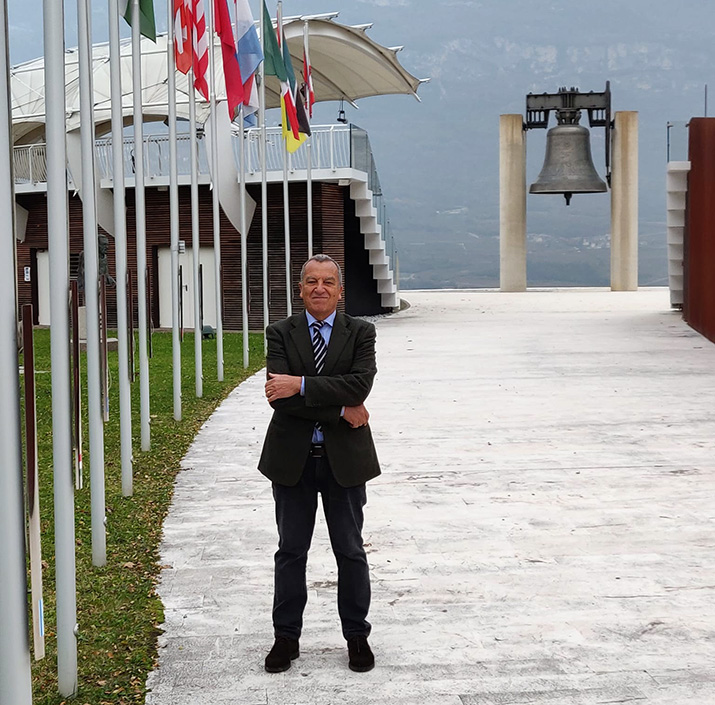
A NEW COURSE BETWEEN CONTINUITY AND INNOVATION
The Bell has changed after 17 years. A new president has arrived, “Reggente” Marco Marsilli who succeeds Senator Alberto Robol. The first thanks of the newly elected went to the Foundation Board. "My commitment will be to show myself deserving of the trust that has been placed in me", said Marsilli highlighting the intention to make use, within the scope of their respective competences, of the collaboration of Executive Committee members and aforementioned Board. The thought then went to his predecessor, capable in fulfilling a position for over three decades "during which the Foundation has seen its effectiveness and prestige grow considerably". The prospect, he continued, is "to start my mandate with the qualities of continuity with the recent past, in a vision that draws attention to the territory consolidated with an international perspective, thanks to the fundamental support of the Province of Trento and the Municipality of Rovereto "
Let's start with the territory?
It is necessary to strengthen the already strong roots of the Bell of the Fallen, and consequently of the Foundation, with the natural area of reference for Maria Dolens, consisting of Rovereto, Vallagarina and the Province of Trento, but without disdain for other Italian regions. It is a question of intercepting and conveying the wishes and expectations of all those who identify Maria Dolens as a symbol of peace, respect for human rights and solidarity among peoples on the Colle di Miravalle. This implies a great willingness by the Foundation towards the civil, religious, cultural, sporting, educational and artistic needs that may deepen our knowledge. Wherever they are.
And going abroad?
An international vocation is already present in Maria Dolens' DNA. It is the great intuition of the founder who used the bronze donated by the 19 belligerent countries in the First World War in the first casting of 1924. The path was already marked and it is no coincidence that the Foundation benefits from a privileged status with the two major multilateral organizations operating in the field of human rights. I am referring to the partnership with the Council of Europe in Strasbourg, which has been underway since 2006, and that with the United Nations in New York, which began in 2009. These relationships do not represent formal recognition but translate into targeted participation by Foundation members at events and meetings of the two bodies in order to develop initiatives focused on the values represented by the Bell. Furthermore, the network of relationships woven through the presence in these international offices favours and strengthens the collaboration started some time ago with the foreign embassies in Rome, helping to create the conditions for new affiliations to the Peace Memorandum. Up to now, 99 flags have been hoisted at the Colle representing countries and peoples. We are preparing to reach the symbolic number of 100, but this round figure must represent a starting point. The Foundation's core business is the promotion of the values represented by Maria Dolens, first and foremost peace.
How do we act in this direction?
Culture and diplomacy are two fundamental tools for mutual knowledge between people. They represent the structural basis necessary in order to gradually overcome crisis situations. I believe that the Bell must set realistic goals and I believe in symbolic gestures. In relation to this I wish to recall the initiative that saw two great chess masters, the Russian Vladimir Dobrov, and the Ukrainian, Valeriy Nevyerov, challenge each other at the Colle hill, at the same time that the troops of Kiev and Moscow were engaged in fierce fighting in the Donbass area. This is a small example of how the spirit of the Bell of the Fallen can help create a better climate even in objectively difficult situations
How does this hope translate into concrete action?
Certainly ordinary activity needs to be strengthened, but I believe that in general, in order to take concrete action, we cannot ignore the context, and at this specific moment we need to creatively face the challenges that the pandemic poses. We are in a period in which it is very difficult, if not impossible, to travel and organize events in person. In 2020, for example, all meetings in Strasbourg and New York were cancelled. The activity of the Bell did not stop completely, in fact I remember the recent adherence to the Peace Memorandum of Georgia and Ireland, but the difficulties cannot be denied. For this reason, it is advisable to equip oneself with tools that focus on new technologies to ensure an alternative offer to the traditional one, for example by allowing "access" to the monumental area and the Bell through virtual visits. This is an approach that would normally be complementary to face-to-face activity, but which in this period risks becoming prevalent. It does however open up to a new type of "access" that may be developed even after this emergency has passed.
A new form of communication for Maria Dolens?
It is a necessity and it must be done continuously. With this in mind, this same monthly newsletter has been introduced, which will contain a series of information on the life of the Bell and on the main international issues that the Foundation will be called upon to handle during its activity. But that's not enough. The presence on social networks must be potentialized since they can reach sections of the population other than those situated by the Colle di Miravalle hill with their agile and targeted languages.

"Reggente" Marco Marsilli






